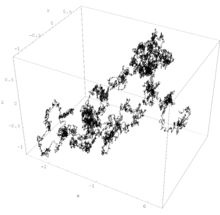

In the mathematical field of probability, the Wiener sausage is a neighborhood of the trace of a Brownian motion up to a time t, given by taking all points within a fixed distance of Brownian motion. It can be visualized as a sausage of fixed radius whose centerline is Brownian motion. The Wiener sausage was named after Norbert Wiener by M. D. Donsker and S. R. Srinivasa Varadhan (1975) because of its relation to the Wiener process; the name is also a pun on Vienna sausage, as "Wiener" is German for "Viennese".
The Wiener sausage is one of the simplest non-Markovian functionals of Brownian motion. Its applications include stochastic phenomena including heat conduction. It was first described by Frank Spitzer (1964), and it was used by Mark Kac and Joaquin Mazdak Luttinger (1973, 1974) to explain results of a Bose–Einstein condensate, with proofs published by M. D. Donsker and S. R. Srinivasa Varadhan (1975).